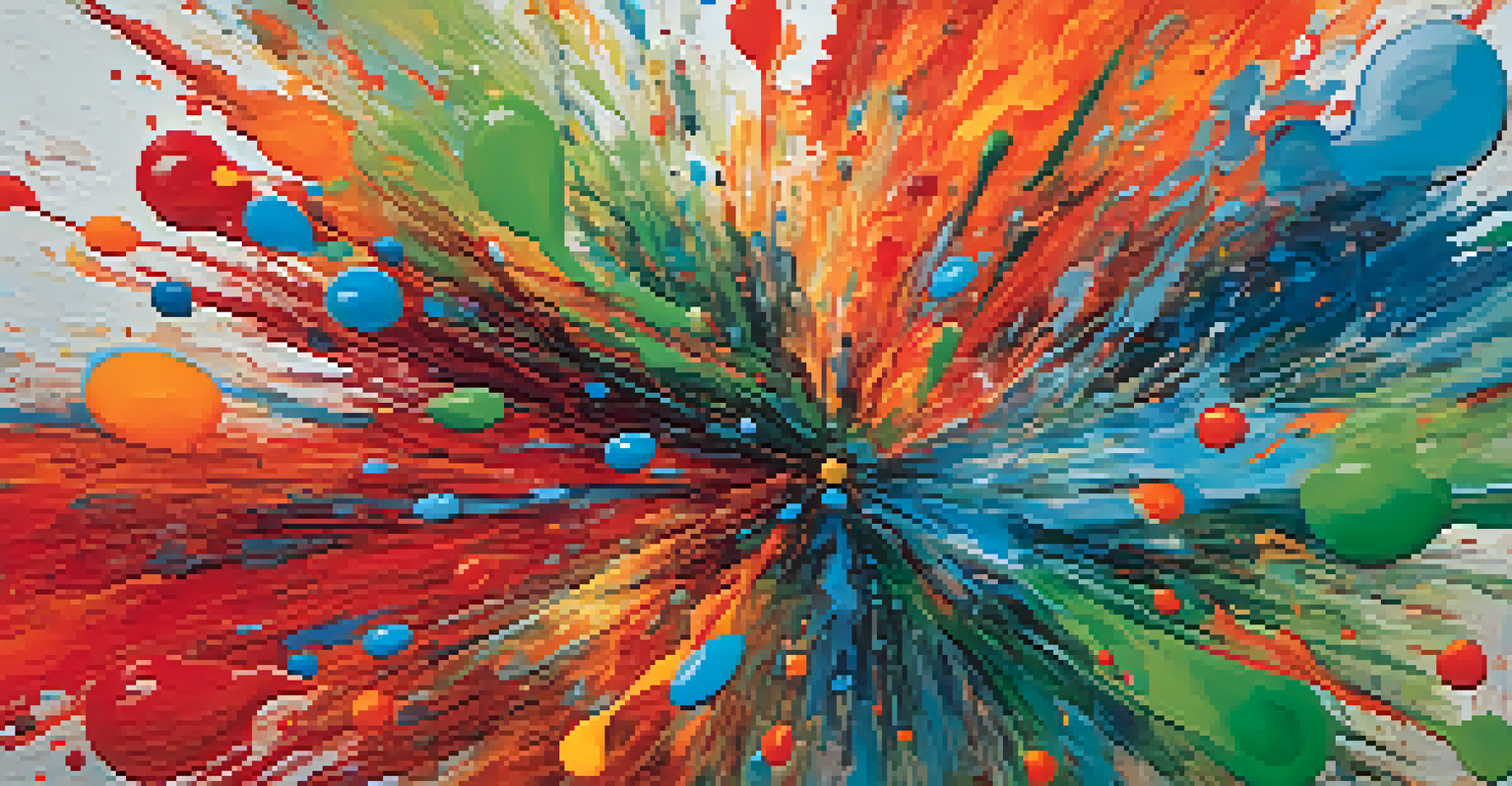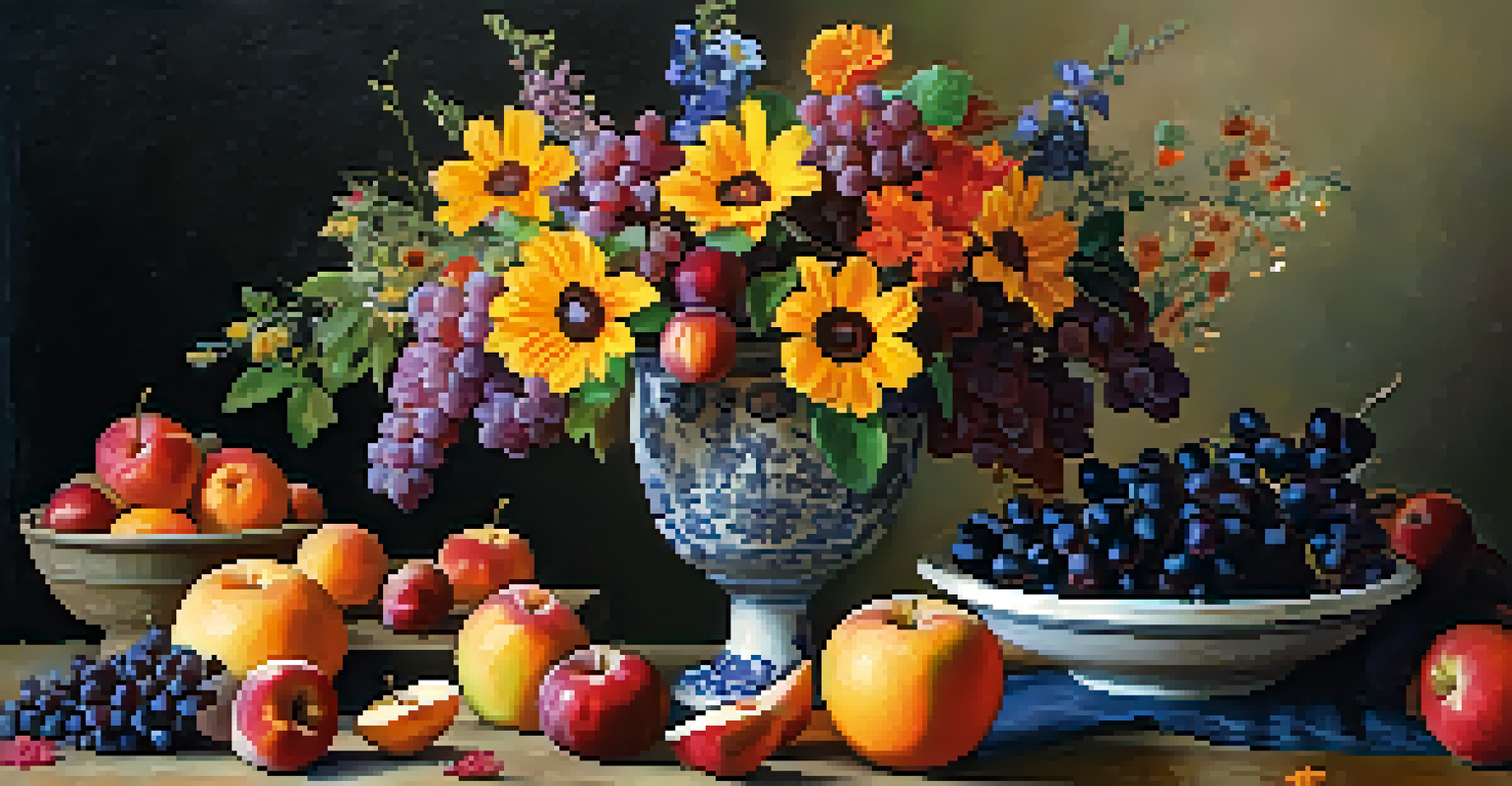The Symbolism of Colors in Art and Memory Association

Understanding Color Symbolism in Art
Color symbolism is a fascinating concept that permeates various art forms, influencing not just the artwork itself but also the emotions it stirs in viewers. Different colors evoke specific feelings and associations, creating a connection between the artwork and its audience. For example, red often symbolizes passion or anger, while blue can evoke calmness or sadness, setting the tone for the interpretation of the piece.
Color is the keyboard, the eyes are the harmonies, the soul is the piano with many strings.
Artists have long used colors strategically to convey messages and evoke reactions. A vibrant yellow might suggest happiness and optimism, while darker hues like black can represent mourning or mystery. This intentional use of color is not only a tool for aesthetic appeal but also a language through which artists communicate their ideas and emotions.
Thus, understanding color symbolism can enhance our appreciation of art. By recognizing what certain colors represent, we can delve deeper into the artist's intentions and the emotional landscape they aim to create, enriching our overall experience of the artwork.
The Psychological Effects of Color
Colors have a powerful psychological impact that can influence our feelings and behaviors. For instance, studies have shown that certain colors can affect our mood and even our productivity. This psychological aspect of color is why many brands carefully choose their color palettes to align with their desired emotional response from consumers.

In art, the psychological effects of color can be harnessed to create specific atmospheres or evoke particular memories. A warm, earthy palette might evoke feelings of nostalgia and comfort, while stark contrasts can create tension and drama. By manipulating color, artists can tap into the viewer's subconscious, guiding them to experience the artwork in a specific way.
Color Evokes Emotion in Art
Colors are strategically used by artists to convey specific emotions and create a visual language that resonates with viewers.
Moreover, understanding these psychological effects can help us better connect with art on a personal level. When we recognize how colors influence our emotions, we can reflect on our responses to artwork and appreciate the artist's craft in eliciting those feelings.
Cultural Differences in Color Interpretation
Color meanings can vary dramatically across different cultures, making color symbolism a rich field of study. For instance, while white is often associated with purity and weddings in Western cultures, it can symbolize mourning in some Eastern cultures. This cultural context adds layers of meaning to art, as viewers bring their own experiences and interpretations to the piece.
Colors are the smiles of nature.
Artists who are aware of these cultural differences can incorporate them into their work, either to challenge perceptions or to celebrate diversity. By using colors that resonate differently with various audiences, they can create a dialogue that transcends geographical boundaries. This can lead to a more profound appreciation of the artwork as it engages with multiple interpretations.
Understanding these cultural nuances is essential for anyone looking to fully grasp the depth of color symbolism in art. It reminds us that art is not just a solitary experience; it’s a shared exploration of human expression across different backgrounds.
Color and Memory: A Personal Connection
Many people have personal associations with specific colors, often tied to significant memories or experiences. For example, a bright green might remind someone of a childhood summer spent in nature, while the color blue could evoke memories of a serene beach vacation. These personal connections can enhance our emotional engagement with art, making it more meaningful.
This phenomenon highlights the subjective nature of color perception. What one person sees as calming might be energizing to another, depending on their unique life experiences. Artists can tap into this by using colors that resonate with common experiences, creating a sense of shared memory and connection among viewers.
Cultural Interpretations of Color
Color meanings vary across cultures, adding layers of depth to the interpretation of art as viewers bring their own experiences.
By acknowledging our memories tied to colors, we can enrich our understanding of art. This interplay between color and memory not only enhances our appreciation but also allows us to reflect on our personal narratives within the context of the art.
Using Color to Convey Emotion in Art
Artists often use specific colors to convey emotions, creating a visual language that transcends words. For instance, a painting dominated by cool colors like blue and green might evoke feelings of tranquility, while a piece heavy in reds and oranges could inspire feelings of excitement or unrest. This emotional communication is a vital aspect of how we interpret art.
The choice of color palette can significantly impact the viewer's emotional experience. An artist might deliberately select contrasting colors to create tension or harmony, guiding the viewer's emotional journey through the artwork. This intentionality in color use shapes not only the visual appeal but also the emotional resonance of the piece.
Ultimately, understanding how color conveys emotion can deepen our engagement with art. As we become more aware of this connection, we can appreciate the artist's choices and the emotional landscapes they create, allowing us to experience the artwork on a more profound level.
The Role of Color in Art Movements
Throughout art history, various movements have embraced specific color theories that reflect broader societal changes and philosophies. For instance, Impressionism celebrated the use of light and color to capture fleeting moments, while Expressionism used bold colors to express deep emotional states. Each movement's approach to color reveals not just artistic preferences but also cultural sentiments of the time.
By examining these movements, we can see how color serves as a barometer for emotional and social change. The palettes of these movements often reflect the artists' responses to their world, making color a powerful tool in narrating history through art. Understanding these trends can offer insights into how artists have used color to communicate their perspectives.
Personal Memories Linked to Color
Individual associations with colors can enhance emotional engagement with art, making the experience uniquely personal.
This historical context enriches our appreciation of color in art. As we explore how different movements utilized color, we can gain a deeper understanding of the artists’ motivations and the societal influences that shaped their work.
Conclusion: The Lasting Impact of Color in Art
The symbolism of colors in art is a complex interplay of emotional, cultural, and psychological factors. As we have explored, colors do more than simply beautify a piece; they convey deep meanings and evoke personal memories. This multifaceted nature of color makes it a vital aspect of art appreciation.
By understanding the various dimensions of color symbolism, we can enhance our experience of art. We become more attuned to the messages artists convey and the emotions they evoke, allowing us to connect with the artwork more intimately.

In the end, the lasting impact of color in art lies in its ability to bridge gaps between artist and viewer, creating a shared journey through emotion, memory, and meaning. As we continue to explore this vibrant world, we open ourselves up to new interpretations and deeper connections with the art we encounter.